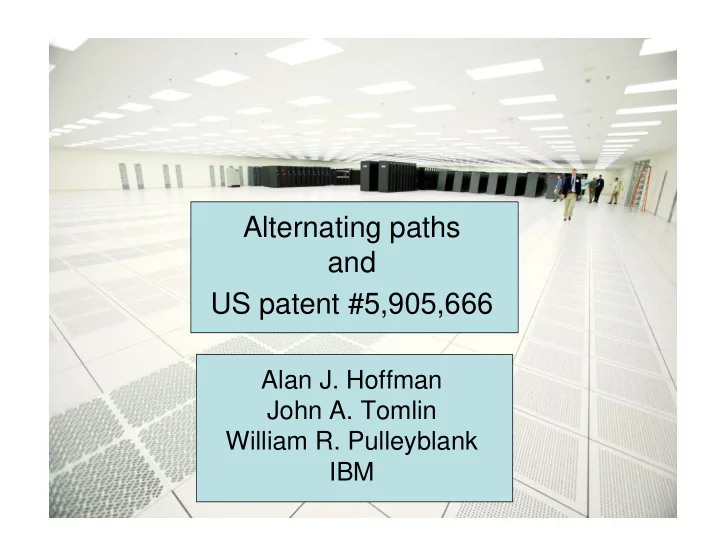

Alternating paths and US patent #5,905,666 Alan J. Hoffman John A. Tomlin William R. Pulleyblank IBM
US Patent 5,905,666 PROCESSING SYSTEM AND METHOD FOR PERFORMING SPARSE MATRIX MULTIPLICATION BY REORDERING VECTOR BLOCKS
The problem: Efficiently computing Ax and yA • Linear programming: – Primal: max cx , Ax = b, x m 0 – Dual: min yb, yA m c – Requires computation of Ax and yA • Simplex algorithm: – Small number of computations of Ax, but many computations of yA when performing pricing • Critical to performance of algorithm • Interior algorithms – Many fewer iterations, but require similar number of computations of Ax and yA
Computational details - yA # # . . . # # # . . . . # # . . # # # # # . . . # . # # # . # . . . # . # . y . # . # # # # . . # . . # . . . # # . . . # # . . # . . . # . # # . . # . # . . . # # # # # # # # . . A Problem: typically the matrices are sparse in practice, typically 4 to 8 nonzeros per column Partition matrix based on the number of nonzeros per column Row indices of nonzeros Nonzero values
Now we can focus on dense submatrices # # # # # values y indices A Normal (scalar) computation: 18 machine cycles per calculation; 15 cycles initialization Vector Unit computation: 180 machine cycles to startup, 4 cycles per calculation - Require approximately 12 elements to break even row of A y - so, do computation by rows - Use indices to select components of y -Use “accumulator” to compute y * A j Expanded y y * A Expanded indices
What goes wrong with the computation of Ax ? * = A Ax Indices of nonzeros x Entries in index rows now specify which component of Ax is being computed. If all entries in each index row are distinct, then it works. If there are duplicate entries, then we can attempt to permute the entries in each column to eliminate duplicates.
Example Suppose A has 16 rows, and our block has 12 columns and 3 rows. 1 3 1 16 15 2 2 14 7 5 7 6 Index matrix 2 4 5 15 11 8 9 4 11 3 3 8 6 1 6 4 9 7 14 12 10 11 8 13 Columns of submatrix of A . . . Rows of A Bipartite graph representation
Applying Koenig’s edge coloring theorem • Let d be the number of rows in the submatrix. Permuting the entries in each column, so that no row contains duplicates, is equivalent to edge coloring the bipartite graph with d colors. • By Koenig’s theorem, this is possible if and only if each node of the bipartite graph has degree at most d , which is equivalent to each index appearing at most d times in the submatrix. • We need an efficient way to obtain the edge coloring. If there is no coloring, because some index occurs too often, we can permute these to the last row and reduce the size of the block.
Alternating path based proof • Faber, Ehrenfeucht and Kierstead (1982) presented an alternating path based proof: – Start with any coloring of the edges. – If some node v is incident with two identically colored edges c 1 , then some edge color c 2 must be missing – Switch the edges in a c 1 -c 2 alternating path’ v v
Matrix interpretation • Start with any permutations in the columns of the submatrix; process columns left to right, top to bottom c 1 c 1 Row with duplicate c 1 Swap these Two entries c 2 Row not containing c 1 in processed part If this creates a c 2 conflict with processed elements, it involves original row, repeat.
Computational results Average # of Model Rows Columns Nonzeros nonzeros per column BandM 185 340 1670 4.9 Degen2 381 473 3580 7.5 25FV47 715 1484 9994 6.7 PILOTS 1374 3361 40757 12.1 Degen3 1412 1727 24465 14.2 Mod41 34952 94752 210211 2.2 Mod42 40022 110475 244439 2.2 MPS4 90482 219249 502943 2.3
Computational results Model No. of Ax Old Ax Reordering New Ax No. of yA Total yA calcs. time time calcs. time time BandM 79 0.056 0.007 0.043 46 0.018 Degen2 68 0.101 0.020 0.062 40 0.028 25FV47 134 0.486 0.044 0.416 79 0.099 PILOTS 184 2.440 0.216 1.662 109 0.523 Degen3 93 0.676 0.089 0.462 53 0.186 Mod41 213 17.672 1.340 11.209 127 3.793 Mod42 278 26.746 1.289 17.169 166 5.863 MPS4 408 82.826 3.361 43.543 244 18.187
Reference A.J. Hoffman, W.R. Pulleyblank, J.A. Tomlin, On computing Ax and π T A , when A is sparse, Annals of Numer. Math. 4 (1997) 359-367.
Recommend
More recommend